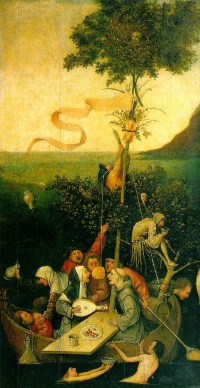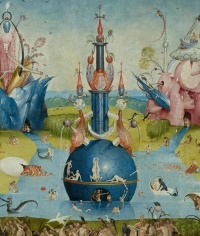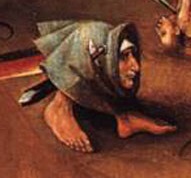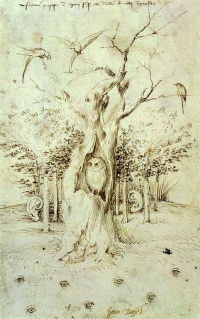Hieronymus Bosch
From The Art and Popular Culture Encyclopedia
|
"A unique painter in the Flemish tradition was Hieronymus Bosch (about 1450-1516). In his ideology medieval fantasy and grotesquerie reached a zenith. But his inexhaustible, audacious fantasy, which invented all kinds of diabolical creatures, found expression in clear, skillfully organized pictorial forms. Usually a landscape or an architectural framework, receding into space, provided the setting for figures that show Northern realism in detail and Gothic linealism in the crisp edges of the color areas, strongly opposed in value. All this is evident in any of his versions of The Temptation of Saint Anthony, a subject he painted frequently." --Gardner's Art Through the Ages (1926) by Helen Gardner "Hieronymns (Jerome) Bosch [...] was a painter of strongly marked individuality [...] His peculiarity lay in his treatment of the most wildly fanciful subjects, such as sins and their punishment in hell. These, as being at once farcical and terrible, soon became extremely popular, and found many imitators. At the same time he could deal skilfully with simpler subjects, giving them a very piquant humour and realism ; these compositions are best known from engravings of the sixteenth century. [...] In spite of his grotesque humour, Bosch is a very noteworthy master; his execution is free and broad, clear and sure, and as a colourist he is successful in harmonising vivid local tints into a bright and glowing tone."--History Of Painting Vol II The Painting Of The Renascence (1885) by Woltmann and Woermann "Another Dutchman, Hieronymus Bosch, made himself a name as a visionary. All those grimacing images which were customary in mediaval decorative art, especially in the stone ornaments of Gothic cathedrals and the wood carvings of the choir stalls, were transferred by him to panel painting. He is especially fond, as was Teniers at a later day, of giving fishes the wings of bats and of creating strange monstrosities by commingling the forms of animals and vessels. Any one expecting the fantastic in our sense of the term, the demonic and the ghostly, would be bitterly disappointed: for his paintings have not a fantastic, but a burlesque or rather a didactic effect. His practice of giving them the form of an altar is characteristic of their significance. Whether he represents the Seven Deadly Sins, the Ship of Fools, the Pleasures of the World or the Temptation of St. Antony, it is always a sermon beginning with the fall of man and ending with hell. At the same time that Luther threw the inkstand at the devil, the last representation of the devil as the middle age conceived him passed away with Bosch. At a time when gluttony and wild sensuality had followed upon the former mortification of the flesh, he swung, as did Hogarth later, the heavy moral club, practised the art of "hanging people in colours,” and painted the same Capuchin sermons with which Sebastian Brant, Geiler von Kaisersperg, and Thomas Murner regaled their hearers."--The History of Painting: From the Fourth to the Early Nineteenth Century (1893/94) by Richard Muther |



|
Related e |
|
Featured: |
Hieronymus Bosch (c. 1450 – 1516) was an Early Netherlandish painter best known for his avant la lettre surrealism exemplified in the painting The Garden of Earthly Delights.
Contents |
Art
Bosch produced several triptychs. Among his most famous is The Garden of Earthly Delights. This painting depicts paradise with Adam and Eve and many wondrous animals on the left panel, the earthly delights with numerous nude figures and tremendous fruit and birds on the middle panel, and hell with depictions of fantastic punishments of the various types of sinners on the right panel. When the exterior panels are closed the viewer can see, painted in grisaille, God creating the Earth. These paintings have a rough surface from the application of paint; this contrasts with the traditional Flemish style of paintings, where the smooth surface attempts to hide the fact that the painting is man-made.
Bosch never dated his paintings and may have signed only some of them (other signatures are certainly not his). Fewer than 25 paintings remain today that can be attributed to him. Philip II of Spain acquired many of Bosch's paintings after the painter's death; as a result, the Prado Museum in Madrid now owns several of his works, including The Garden of Earthly Delights.
Themes and contemporary relevance
Many of his works depict sin and human moral failings. Bosch used images of demons, half-human animals and machines to evoke fear and confusion to portray the evil of man. The works contain complex, highly original, imaginative, and dense use of symbolic figures and iconography, some of which was obscure even in his own time. He is said to have been an inspiration for the surrealist movement in the twentieth century.
Interpretations
In the twentieth century, when changing artistic tastes made artists like Bosch more palatable to the European imagination, it was sometimes argued that Bosch’s art was inspired by heretical points of view (e.g., the ideas of the Cathars and putative Adamites) as well as of obscure hermetic practices. Again, since Erasmus had been educated at one of the houses of the Brethren of the Common Life in 's-Hertogenbosch, and the town was religiously progressive, some writers have found it unsurprising that strong parallels exist between the caustic writing of Erasmus and the often savage painting of Bosch. "Although the Brethren remained loyal to the Pope, they still saw it as their duty to denounce the abuses and scandalous behaviour of many priests: the corruption which both Erasmus and Bosch satirised in their work". (The Secret Life of Paintings, Richard Foster & Pamela Tudor-Craig)
Others, following a strain of Bosch-interpretation datable already to the sixteenth-century, continued to think his work was created merely to titillate and amuse, much like the "grotteschi" of the Italian Renaissance. While the art of the older masters was based in the physical world of everyday experience, Bosch confronts his viewer with, in the words of the art historian Walter Gibson, "a world of dreams [and] nightmares in which forms seem to flicker and change before our eyes." In one of the first known accounts of Bosch’s paintings, in 1560 the Spaniard Felipe de Guevara wrote that Bosch was regarded merely as "the inventor of monsters and chimeras". In the early seventeenth century, the Dutch art historian Karel van Mander described Bosch’s work as comprising "wondrous and strange fantasies"; however, he concluded that the paintings are "often less pleasant than gruesome to look at." (tr. Gibson)
In recent decades, scholars have come to view Bosch's vision as less fantastic, and accepted that his art reflects the orthodox religious belief systems of his age. His depictions of sinful humanity, his conceptions of Heaven and Hell are now seen as consistent with those of late medieval didactic literature and sermons. Most writers attach a more profound significance to his paintings than had previously been supposed, and attempt to interpret it in terms of a late medieval morality. It is generally accepted that Bosch’s art was created to teach specific moral and spiritual truths in the manner of other Northern Renaissance figures, such as the poet Robert Henryson, and that the images rendered have precise and premeditated significance. According to Dirk Bax, Bosch's paintings often represent visual translations of verbal metaphors and puns drawn from both biblical and folkloric sources. However, the conflict of interpretations that his works still elicit raise profound questions about the nature of "ambiguity" art of his period.
Biography
His true name was Jheronimus (or Jeroen) van Aken (meaning "from Aachen"). He signed some of his paintings with Bosch (pronounced as Boss in Dutch), derived from his birthplace 's-Hertogenbosch. In Spanish, he is often called El Bosco.
Born to a family of Dutch and German painters, he spent most of his life in 's-Hertogenbosch, a flourishing city in fifteenth century Brabant, in the south of the present-day Netherlands. In 1463, some 4000 houses in the town were destroyed by a catastrophic fire, which the then (approximately) 13-year-old Bosch may have witnessed. He became a popular painter and even received commissions from abroad. In 1488 he joined the Brotherhood of Our Lady, an arch-conservative religious group of some 40 influential citizens of 's-Hertogenbosch and some 7000 'outer-members' from all over Europe.
References
- Bax, Dirk. (1949), “Ontcijfering van Jeroen Bosch”. Den Haag.
- Gibson, Walter S (1973). “Hieronymus Bosch”. New York: Thames and Hudson. ISBN 0-5002-O134-X
- Koldeweij, Jos & Bernard Vermet & Barbera van Kooij: Hieronymus Bosch. New Insights Into His Life and Work, NAi Publishers, Rotterdam 2001. ISBN 9-0566-2214-5
See also




